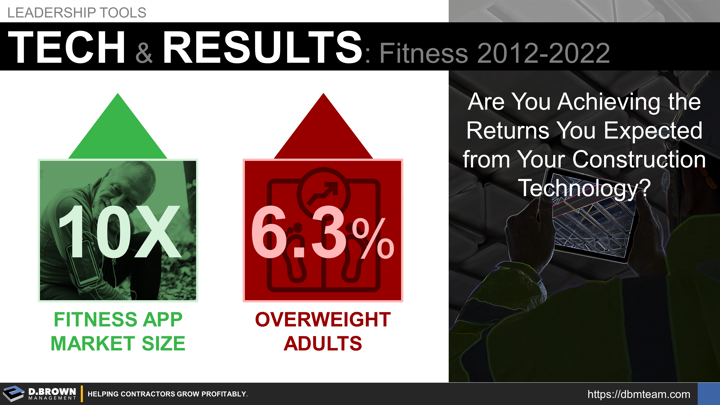Disclaimer: This post has nothing to do with bodyweight - it is just a very measurable example.
If technology, including real-time reporting, was a primary driver of results, we would be seeing a dramatic increase in health given the proliferation of fitness wearables and tracking applications (reporting) including many with elements like socialization and gamification built in.
What we have seen is a dramatic inverse relationship. Depending on which source of data you look at and what you include, the fitness tracking app market has grown about 10X over the 10 years ending in 2022. In 2012 the market was measured in millions of dollars and by 2022, it was a multi-billion dollar market projected to continue growing at a Compounded Annual Growth Rate (CAGR) of 30% through 2030 and beyond.
At the same time, the rate of overweight adults in the US grew by 6%. Worldwide growth of the fitness market and overweight adults is growing similarly.
With the dramatic increase in technology and real-time feedback, we should have reasonably expected dramatically different results - construction technology is similar.
It will be a long time (if ever) before the individualized real-time feedback that we have with fitness wearables and apps makes its way to the construction industry.
This is not to say that technology is heading in the wrong direction.
What we need to look at is how the technology is integrated and managed. Before investing in technology, ask yourself a few of these questions.
- What is your own personal history with adapting to changes and developing new habits? Look at personal and professional for this. Technology is a tool just like a piece of construction or exercise equipment. Used properly and consistently, it will produce results over time. The Power of Habit is a good place to start learning.
- What is your team's history with adapting to changes and developing habits that are shared and integrated? This comes down to details like scheduling. For example, a family with two people working and two kids may have to coordinate exercise schedules with work and childcare schedules. A place to start is looking at the team in relationship to where they are on the Diffusion of Innovations Curve.
- Do you have a clear process including standards, workflows, procedures, and feedback loops for how some aspect of the Contractor Business Model should be done. For example, processing changes.
- Is your team currently following the defined process consistently?
- Given your growth trajectory, including any required changes to your strategies, will this process scale?
- If you are comfortable with your answers above, how can technology help streamline the process even more? Technology is amazing when it is sitting on a foundation of great people and processes aligned with a clear market strategy.
These six questions can help you make much better decisions about your technology investments both professionally and personally.
An experienced and unbiased 3rd party can be invaluable as a sounded board for these questions.
All relationships begin with a simple conversation.

